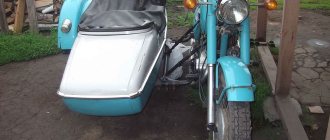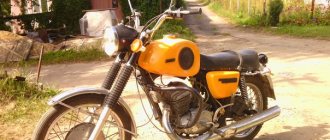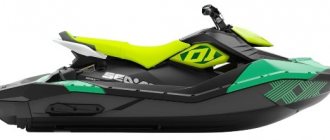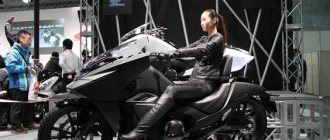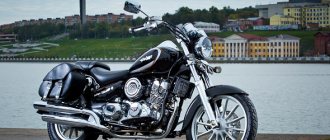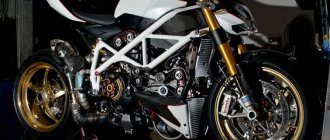With the end of the Soviet-German war, during the 40s and 50s, a real motorcycle boom began to be observed in the Soviet Union. This can be explained by the fact that after the end of the war, many captured models of various brands of motorcycles came to the USSR, which Soviet craftsmen first successfully copied, and then completely went into a free flight of engineering creativity, using the developments of foreign colleagues already to the extent that they relied more on Now it’s up to your own skills and imagination.
What's better?
JupiterPlanet
This approach has led to the fact that the Union market has been flooded with entire series of high-quality motorcycles of a wide variety of production and for a variety of purposes. And if we take into account that the market in the Soviets, one might say, was topsy-turvy, then it was not “demand that gave birth to supply,” but on the contrary, supply gave birth to demand - once something of high quality and affordable appeared in access, then you need to take it. But this did not mean that the developers approached their work carelessly. Proof of this is the two motorcycles of the IZH series - Jupiter 5 and Planet 5.
Unknown "Izh": cars that did not go into production
Of all the Soviet automobile plants, Izhevsk Automobile Plant was perhaps the most unusual. And this did not apply to manufactured products, but to departmental affiliation. IzhAvto was created with the direct participation of the then Minister of Defense Dmitry Ustinov and was called upon, along with VAZ, to increase the availability of passenger cars for Soviet citizens. The idea seemed excellent to everyone: on the one hand, the military-industrial complex would at least partially “justify” in the eyes of citizens the huge sums invested in it and would produce a completely peaceful product; on the other hand, the emergence of jobs, the purchase of equipment and prospects for young people, typical for the opening of a new production. IzhAvtoo opened in 1966 and began producing Moskvich-408. The country was arguing all over who makes “Muscovites” better: the capital’s AZLK or the “military” Izh? Meanwhile, production increased and it was time to think about our own developments. The first-born in 1973 were the Izh-2125 Combi hatchback and the Izh-2715 van, popularly nicknamed the “heel” for its characteristic body shape. It is worth noting that the notorious “turn signals” are side lights. It was with this cladding that the “412th”, after modernization in 1982, began to differ in appearance from its “Moscow brother”.
The photo shows an Izh-Kombi with “scarce” GDR headlights and a chrome radiator grille. A prestigious model for those times and the first hatchback in the USSR (although officially it was more like a liftback). This story, however, is widely known. But the concept cars of Izhevsk residents looked much more modern and interesting. So, the first-born in the galaxy of cars designed to occupy the same niche in the country as the promising “penny” was the Izh-13 Start. Development of the vehicle began in 1968, and a prototype was ready in 1972. The car had an unusual modern design with a number of characteristic elements (air intakes in the rear roof pillars, a window line falling towards the front, beautiful rear lights) and front-wheel drive, which at that time in the USSR was more than skeptical. In addition, by 1972, the production of “kopecks” was already a decided matter, and the country could not afford the production of two “classmates” at once. In addition, this would inevitably entail a comparison of cars, at least from the point of view of body architecture, and the “programmed” lag of the VAZ would become too obvious.
The Izh-13 with front-wheel drive and an aerodynamic hatchback body could have become a full-fledged participant in the traffic flow in the seventies.
Search sketch. The body is still three-door. Drawing from the page of user Vadim Gusmanov
Model of Izh-13 and its creators. The headlights and “dimensions” are covered with transparent caps.
Obviously winter tests. Pay attention to the taillights. On VAZs a similar design will appear only a decade later on the “five”. The wheels are more reminiscent of Volkswagen ones.
"Start" in the factory museum. Photos here and below by Dmitry Dubovtsev
Almost simultaneously with the Izh-13, Ustinov was presented with the Izh-14 SUV, which is often compared with the Niva. Indeed, the outwardly unprepossessing little white car has many similarities with the world-famous SUV. Despite the obvious loss in design, the car also had an undoubted advantage - the drive could switch from full to front or rear, depending on the situation. In addition, the development of the Izh was two years ahead of the Niva, which, however, did not prevent them from soon meeting at the training ground, where the Izh demonstrated insufficient dynamic characteristics compared to the Niva. However, Niva also lost to Range Rover in terms of them. One way or another, the Ministry of Defense did not want to allocate funds for fine-tuning and mastering the production of the “raw” model, so VAZ again won the palm in this race. What factors were decisive in this case - technological, economic or purely lobbying - now no one will say for sure.
Izh-14. Not handsome. However, please note what was mentioned above. “Muzzle” still contains the same appearance details as “Start” and “Combi”. You can read more about this car here. The next prototype, also doomed to failure, was the Izh-19 “Start Combi”, the design of which was a development of the solutions found in the Izh-13 “Start”. The Kombi, however, already had a more controversial appearance and finally “lost its face”, turning into a kind of Japanese hatch of the seventies with a claim to sportiness. However, there is no arguing about tastes, and the car for that time really looked more than avant-garde, especially against the backdrop of the rapidly aging Zhiguli and Volga. The 1975 development, based on the units of the same “four hundred and twelve”, had a fast wedge-shaped body, handles recessed into the doors and an unusually raised stern with vertical lights, which, it seems, without any special changes, would migrate to the Moskvich-2142 two decades later. By the way, even the Izh-19 ideology itself seemed to be vicious at that time. After all, the car was positioned as a “youth car”, although the Ministry of Auto Industry did not find the necessary funds for “adult” cars...
The next development of the Izhevsk Automobile Plant finally reached the assembly line... twenty years later. This is the long-suffering Orbit/Oda, or Izh-2126. The mosaic of the achievements of the Soviet automobile industry over the past thirty years, as we are accustomed to seeing it on the streets of the city, was not always like this. And the advertising slogan, which sounds like a mockery: “modern, Russian, inexpensive,” would have been quite appropriate at the time of development. However, during the lengthy development process, political ups and downs in the country and periodic problems with financing, the “Oda” on its way to the consumer became completely outdated and in automotive articles it was most often contrasted with the VAZ “classic”. The first prototype of “Orbit” (we will call it that for convenience) appeared in 1979 and bore the letter “T”. The car was made in the then fashionable “faceted” style and returned in style to the corporate cladding. Structurally, the car continued to be rear-wheel drive and used components and assemblies of previous models, albeit modernized, which, on the one hand, increased unification, and on the other, added hope for mass production.
Izh2126 series T, 1979 In 1980, series O appeared. In addition to eliminating design flaws identified during state tests, designers “played” with the appearance of the car and made it more modern.
In 1984, an aerodynamically perfected car with a familiar appearance under the name IZH-2126-04 and a suspicious resemblance to the Ford Escort finally passed state tests and was recommended for mass production.
Ford Escort
Izh-2126-04, 1984 Meanwhile, the car periodically flashed on the pages of the press, such a long development could no longer be hushed up and the main question of the population and the media became: “When?” Let's quote one of the issues of the magazine “Modelist-Konstruktor” for 1988: “The car that will be discussed has not yet been put into production, but it is already familiar to those who have visited the Mechanical Engineering pavilion at VDNH of the USSR. The debut of the new basic model “2126” was more than successful. Visitors appreciated the characteristic design features that distinguish it from other promising models of Soviet passenger cars. The technical specifications determined the type of layout of the new car - rear-wheel drive and a 1.5-liter engine.” The “debut”, however, was clearly delayed. Here’s what Za Rulem magazine wrote in 1990 about preparations for production (screen from user diecast43): “There’s a perpetual calendar hanging on the wall right in front of me. In its upper left corner is a color photograph of the car. The varnish on the photo was cracked, the photo itself was warped, the edges were peeling off and bent in some places. In a word, time has treated photography mercilessly. In relation to the car depicted here, it turned out to be even more severe. For more than ten years, a machine that is actually ready for production cannot overcome the difficulties of birth...” The end of the article, however, is more optimistic: “Already now, preparations of the existing production are in full swing to begin the gradual introduction of components and parts of the new car onto existing combis and sedans that are currently being assembled. Every day there are operational meetings, during which the workshops take turns reporting on what has been done and how. A special technology has been developed that will wedge itself into existing production, displace it, and make it possible to assemble the “twenty-sixth” on an old conveyor belt, interspersed with old machines. And not to the detriment of the plan - it will not decrease by a single unit. In a word, difficult, painstaking daily work is underway, the result of which will be brand new Izh-2126 rolling off the assembly line at the end of the year.”
However, “difficult, painstaking and everyday work” actually stretched until the beginning of the 2000s, when it was possible to reach more or less serious production volumes. In addition to everything, the appearance of the car, which had completely lost its novelty, was “diluted” with block headlights from the “nine”, a steering wheel “from the ten” and other parts from cars already in production. In addition, the quality of the samples leaving the plant was clearly below the expectations of correspondent Demchenko in 1990. They tried to modernize Oda several times. At first there was an idea to install headlights from the “fifteenth”, then the restyling was ordered from the I-design studio, and ultimately in 2005 the car was completely discontinued, giving way to the VAZ “classics” and the Korean KIA. (By the way, judging by the information on the plant’s website, Udmurtia has set a course for modernization, so we’ll be expecting NanoIzh soon). PS Of course, the history of the Izh-2126/Orbit/Oda is very tragic and at the same time typical of the USSR in the late eighties, but this car was no longer as bright and as original as the Izh Start or Start Combi. Being a gray “remnant”, like most production domestic cars of the second half of the eighties, it managed to survive perestroika, but naturally could not withstand the competition with used foreign cars. Probably, the “point of no return” for Izh was reached already at the moment of abandoning the production of promising front-wheel drive vehicles, and all subsequent events are only steps towards curtailing its own engineering and becoming a VAZ branch. Sources and useful resources: - Izh-2126 test of the 2001 model in the Autoreview newspaper
— a selection of materials on “Izhu” by diecast43 — Sketches by Izhevsk designers on Vadim Gusmanov’s page
— Photos from the IzhAvto Museum on Dmitry Dubovtsev’s page
